This document discusses variables, data types, arrays, and operators in Java. It defines variables as entities that hold values and data. Variables must be declared with a type like int or string. There are primitive types like int, string, boolean and reference types. Arrays are objects that hold a fixed number of values of a single type, with each element accessed via an index. The document provides details on naming conventions and examples of declaring different variable and array types in Java.
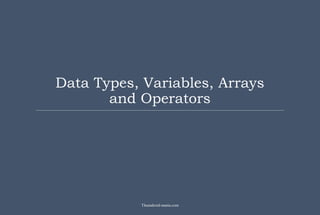
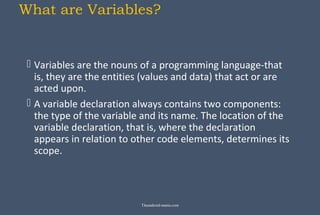

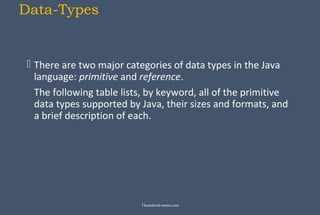

![ Local Variables Similar to how an object stores its state in fields, a method
will often store its temporary state in local variables. The syntax for declaring
a local variable is similar to declaring a field (for example, int count = 0;).
There is no special keyword designating a variable as local; that
determination comes entirely from the location in which the variable is
declared — which is between the opening and closing braces of a method.
As such, local variables are only visible to the methods in which they are
declared; they are not accessible from the rest of the class.
Parameters You've already seen examples of parameters, both in
the Bicycle class and in the main method of the "Hello World!" application.
Recall that the signature for the main method is public static void
main(String[] args). Here, the args variable is the parameter to this method.
The important thing to remember is that parameters are always classified as
"variables" not "fields". This applies to other parameter-accepting constructs
as well (such as constructors and exception handlers) that you'll learn about
later in the tutorial.
Theandroid-mania.com](https://image.slidesharecdn.com/data-20types-20-2cvariables-2carrays-20and-20operators-130515110736-phpapp01/85/Data-types-variables-array-6-320.jpg)
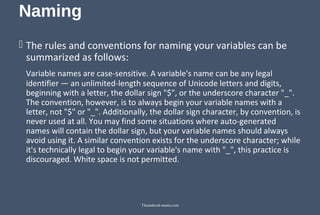

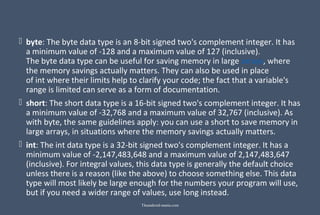

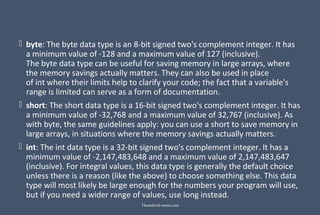
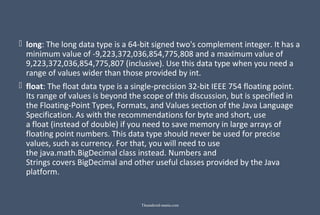
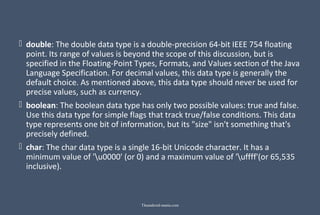
![Arrays
An array is a container object that holds a fixed number of values of a single
type. The length of an array is established when the array is created. After
creation, its length is fixed. You've seen an example of arrays already, in
the main method of the "Hello World!" application. This section discusses
arrays in greater detail.
Each item in an array is called an element, and each element is
accessed by its numerical index
for ex:
declares an array of integers
int[] anArray;
allocates memory for 10 integers
anArray = new int[10];
Theandroid-mania.com](https://image.slidesharecdn.com/data-20types-20-2cvariables-2carrays-20and-20operators-130515110736-phpapp01/85/Data-types-variables-array-14-320.jpg)
![initialize elements
anArray[index] = value;
Similarly, you can declare arrays of other types:
byte[] anArrayOfBytes;
short[] anArrayOfShorts;
long[] anArrayOfLongs;
float[] anArrayOfFloats;
double[] anArrayOfDoubles;
boolean[] anArrayOfBooleans;
char[] anArrayOfChars;
String[] anArrayOfStrings;
Theandroid-mania.com](https://image.slidesharecdn.com/data-20types-20-2cvariables-2carrays-20and-20operators-130515110736-phpapp01/85/Data-types-variables-array-15-320.jpg)